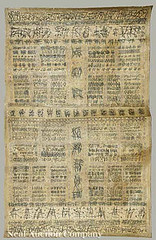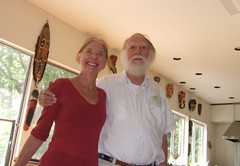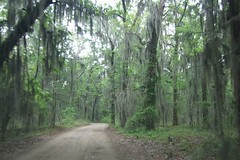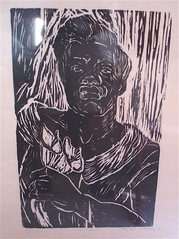In 1959 Clyde Connell and husband, Thomas Dixon Connell (called TD), suffered an enormous dislocation. The peace and security enjoyed by the Connells in the previous 10 years of residence at the Caddo Parish Penal Farm - TD was superintendent - came to a disappointing end as TD was asked to leave his position. He was 2 years short of retirement.
At the Penal Farm Clyde had her own painting studio. With their departure she gave up the first studio she'd known.
The Connells moved to a small camp house on the edge of Lake Bistineau. It was an ignominious retreat. TD attempted to sell real estate. Clyde found herself without the space to store her papers, furniture and art. The papers she'd accumulated in her previous life, one dominated by volunteer work in the Southern Presbyterian Church and attendance at many conferences - were destroyed by her hand.
Three years would pass in the isolation of Bistineau before Clyde felt a sense of confidence about her place in artistic work. During that period she developed her Sun Path series. She found an abstraction of her life on the lake: the wavy lines and circular sun spots in the Sun Paths spoke optimistically of a new day. Her initial desire was to create Sun Paths in sheet metal. Alas, she found that she could not afford the fabrication.
A donation of colored paper enabled her to return to making her accustomed flow of art. She told interviewers, "I wanted to work." She was a prodigious producer. Subsequently she developed a collage series called the Lake Verticals.
For many years she continued to make art from brown paper and mulberry paper. Her fame was based on pieces constructed with wood, found metal, rattan vine, stones and papier mache.
Clyde was able to make several Sun Path series in metal. By the early 1980's she was getting considerable sums for her art. She was represented in galleries in Houston and Dallas. Her Swamp Song series had proven popular. At that point her husband's attitude toward her art took a dramatic upturn.
Mrs. Connell's retreat to Lake Bistineau had been transformed into a triumph.
Monday, August 11, 2008
Clyde Connell, mixed media, 1986, the Al Evans / Harriet Dehan collection
The dramatic mixed media piece you see here is composed of brown paper, mulberry paper, charcoal and graphite. It is a collage, which is the medium from which Clyde made her move into sculpture.
To see it up close is to see a story of an artist in the midst of telling a fairly complex story. That was not typical of Clyde. She understood, like Louis Armstrong did, that a simple story, told in bold fashion, was the best way to communicate.
I have seen enough pieces of Clyde's to call this a transitional piece, although I have not studied enough of her work to say that with certitude. One lesson from curating this exhibit: Clyde was prodigious in her work. We have discovered many more pieces from her early career - pre-Bistineau - than we expected.
On the subject of scholarship in regards this gifted woman, we must recommend that art lovers consider the creation of a Clyde Connell Center. Her story is involved, compelling and lengthy. We hope that one day her audience will demand a place where students and art lovers can find a Clyde Connell archive.
To see it up close is to see a story of an artist in the midst of telling a fairly complex story. That was not typical of Clyde. She understood, like Louis Armstrong did, that a simple story, told in bold fashion, was the best way to communicate.
I have seen enough pieces of Clyde's to call this a transitional piece, although I have not studied enough of her work to say that with certitude. One lesson from curating this exhibit: Clyde was prodigious in her work. We have discovered many more pieces from her early career - pre-Bistineau - than we expected.
On the subject of scholarship in regards this gifted woman, we must recommend that art lovers consider the creation of a Clyde Connell Center. Her story is involved, compelling and lengthy. We hope that one day her audience will demand a place where students and art lovers can find a Clyde Connell archive.
Clyde Connell, 1990, Shreveport: the Al Evans and Harriet Dehan collection
The piece on the left is one of the Tool Persons series. Because there is a bar connecting the upraised arms, it is a particularly appealing one to me. Some of the Tool Persons are tentative and less clearly articulated.
To the right is an example of a Bound Person. It is one swathed in a great deal of linen. The effect is to imply extensive wounds and treatment. Again, Clyde created each one of the Bound Persons separately. In the Deep Roots exhibit at Artspace Shreveport, opening Fri, Sept 19, you will see Bound Persons from the initial and naked stage to this reasonably well-clothed state.
As curators of the Clyde Connell exhibit we have felt engrossed in a meditation on the nature of art and the mind of this creative woman.
You, too, will enjoy seeing much of her artistic evolution in this show.
To the right is an example of a Bound Person. It is one swathed in a great deal of linen. The effect is to imply extensive wounds and treatment. Again, Clyde created each one of the Bound Persons separately. In the Deep Roots exhibit at Artspace Shreveport, opening Fri, Sept 19, you will see Bound Persons from the initial and naked stage to this reasonably well-clothed state.
As curators of the Clyde Connell exhibit we have felt engrossed in a meditation on the nature of art and the mind of this creative woman.
You, too, will enjoy seeing much of her artistic evolution in this show.
Clyde Connell collectors Al Evans & Harriet Dehan, Shreveport
We are happy to have the loan of the outstanding collection of Connells from Al and Harriet from their art-filled house on the edge of Cross Lake.
Al first connected with Clyde's work, he remembers, via a show in NYC.
He became a patron and bought numerous pieces in the 1980's and 90's.
Harriet Dehan is a gifted painter and designer as well as an appreciator of Clyde's work.
Al first connected with Clyde's work, he remembers, via a show in NYC.
He became a patron and bought numerous pieces in the 1980's and 90's.
Harriet Dehan is a gifted painter and designer as well as an appreciator of Clyde's work.
Saturday, August 2, 2008
Lalo Rd, Bossier Parish: the road to Clyde Connell's house
Most of Lalo Road (French names are somehow common on Bistineau though the region is dominated by Anglo families) is paved. Close to the lake there's an unpaved stretch and that's where the Spanish moss suddenly becomes abundant. There's a cattle gap before the section of gravel road which runs parallel to the lake. Today there are maybe half a dozen houses - most used as weekend retreats, or "camps" - around the Connell residence.
Talbot and I asked Clyde and her son, Bryan, whether we could be use her house as the site of our wedding in 1994. Clyde was 93 years old but had long demonstrated love and artistic support for Talbot, her great-niece. They welcomed us with every possible courtesy.
We were married in a downpour of hard Louisiana rain under tall trees in the yard between the house and the lake by Episcopalian minister Walter Bear. Talbot arranged for tents - the rain was basically a big surprise - but canopies connecting the tents had to be improvised. The musicians - Tim Marshall, Charlie Bush, Danny Wilder - braved electric shock from water seepage to sing and strum on the porch. Clyde's petite house was packed. But the food, catered by Vicki Rhymes-Potts, was delectable.
No one who attended it - Oct 15, 1994 - will easily forget that wedding.
One more time: thank you, Bryan!
Talbot and I asked Clyde and her son, Bryan, whether we could be use her house as the site of our wedding in 1994. Clyde was 93 years old but had long demonstrated love and artistic support for Talbot, her great-niece. They welcomed us with every possible courtesy.
We were married in a downpour of hard Louisiana rain under tall trees in the yard between the house and the lake by Episcopalian minister Walter Bear. Talbot arranged for tents - the rain was basically a big surprise - but canopies connecting the tents had to be improvised. The musicians - Tim Marshall, Charlie Bush, Danny Wilder - braved electric shock from water seepage to sing and strum on the porch. Clyde's petite house was packed. But the food, catered by Vicki Rhymes-Potts, was delectable.
No one who attended it - Oct 15, 1994 - will easily forget that wedding.
One more time: thank you, Bryan!
Friday, August 1, 2008
Woodblock print by Clyde Connell from the Caddo Parish Penal Farm,
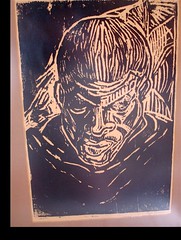
Woodblock print by Clyde Connell from the Caddo Parish Penal Farm, 1950's
Originally uploaded by trudeau
Clyde seemed energized by life alongside black prisoners at the Penal Farm. It reminded her of her childhood on the Dixon plantation. She loved listening to the singing of spirituals. She painted portraits and made woodblock prints of many inmates. She said that she gave most of the pieces to the prisoners.
Luna moth, a print by Clyde with Dixon Ent
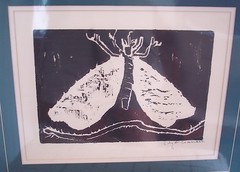
Deep Roots, the life and legacy of Clyde Connell, opens at Artspace Shreveport Sept 19
Originally uploaded by trudeau
Illustration from French magazine Beaux Arts advertising Clyde Connell exhibit in March, 1990

Deep Roots, the life and legacy of Clyde Connell, opens at Artspace Shreveport Sept 19
Originally uploaded by trudeau
We are indebted to Martha for her loan of art, framing of work by Dixon Ent, videotaped interviews of Clyde and deep background stories on the life and travels of Clyde.
Deep Roots, the life and legacy of Clyde Connell, opens at Artspace Shreveport Sept 19.
Subscribe to:
Posts (Atom)
